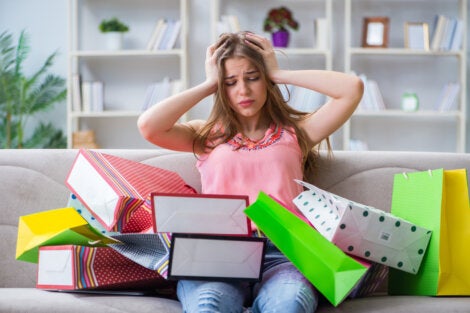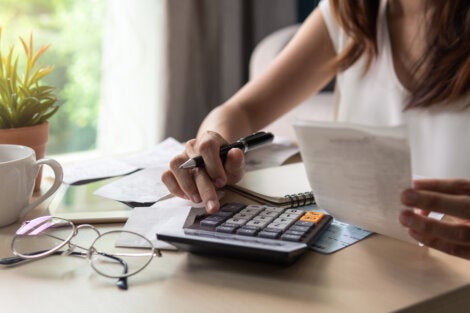Strategies for Controlling Compulsive Buying

Controlling compulsive buying is very challenging for some people. Those who like to shop sometimes find it difficult to control their impulse to buy things they don’t need. They shop because it helps them control their anxiety. Thus, compulsive buying becomes a very unhealthy coping mechanism.
Almost immediately following the relief triggered by their purchase, an individual with compulsive buying disorder (CBD) usually experiences intense guilt and discomfort. Consequently, their anxiety returns full force, and sometimes worse than before. This is a vicious cycle that can significantly harm the individual and those close to them, which is why we want to share some strategies for dealing with it.

Characteristics of compulsive buying
Compulsive buying tends to be related to impulse control disorders. Compulsive buying is also known as oniomania and can be related to mood disorders, eating disorders, and personality disorders. The main characteristics of compulsive buying are the following:
- Buying superfluous and unnecessary items.
- Feeling intensely anxious and worried about being able to possess the item.
- Insomnia triggered by obsessive thoughts about buying the item.
- The uncontrollable desire to shop.
- Feeling immediate satisfaction and relief from your unpleasant symptoms when you buy something.
- Feelings of guilt and dissatisfaction after your initial high.
Having the desired items produces immediate satisfaction. However, as we mentioned above, an individual with CBD often feels embarrassed or guilty that they couldn’t control their impulse to buy something they didn’t need. That guilt is heightened when the purchase wasn’t in their budget or doesn’t match the idea they have of themselves (self-concept dissonance).
The sense that they’re doing something bad leads them to hide their behavior. They sometimes lie about where the item came from and how much it cost. The resulting feelings of shame about being deceitful can trigger anxiety and lead to even more shopping. The desire for the relief they feel when they buy something is overwhelming and overshadows the subsequent guilt and shame. It’s a vicious cycle that’s difficult to break.
Emotions associated with shopping and long-term consequences
Before making a purchase, people with oniomania feel extremely uncomfortable. Buying objects is the only thing that provides relief. As a result, they consider shopping the “magic” solution to their problems.
As you’ve seen, however, that “magic potion” has consequences. On one hand, compulsive buying causes a lot of guilt in the long-term, which triggers more shopping. These vicious cycles are present in any addiction. Compulsive shoppers also build up a tolerance over time, which means they need to buy more each time to get the same sense of relief. Another factor is that compulsive buyers can quickly get themselves into financial trouble. They might have to take out loans or sell some of their belongings to get enough money to keep buying.
Strategies to control compulsive buying
Above all, psychological therapy is key to helping the individual control their habits. A professional can be especially aware during periods of heightened risk. For example, when someone with CBD is spending a lot of time at home with Internet access. Controlling online compulsive buying is much more difficult due to the availability and variety of goods. Paying for things online is also a contributing factor because it’s easy to forget you’re spending real money.
It’s also important for family members to understand the symptoms of this disorder. They can play a very important role in helping their loved one cope with the addiction. Otherwise, there’s a risk that the family itself becomes a source of unpleasant emotions and sensations. If you find out that your partner is spending way over budget, for example, it’s hard not to blame them for the family’s financial problems. Directing blame and guilt towards the addict isn’t helpful at all, and can be a trigger for more buying.
Here are some guidelines for controlling compulsive shopping:
Avoid credit and debit cards
Paying with real money helps foster an awareness of how much you’re spending. It’s harder to hand over a stack of bills than a credit card. As a result, one immediate solution to compulsive buying is to only have access to gift cards. That way, you can only spend what you plan to spend while still enjoying the convenience of not carrying cash.
Estimate a maximum for monthly spending
Set a budget for optional purchases. Avoid rewarding yourself by increasing this amount. It’s great to celebrate when you achieve your goals. But if you have a shopping addiction, that celebration shouldn’t involve buying more. Instead, share your goals with another person and enjoy the recognition they give you when you reach them.
If you’re going to a mall, take public transportation
This will make you think twice about buying too much. If you feel the impulse to make purchases, you’ll have to invest more time and it’ll be less comfortable. The idea of waiting in line and being in crowds can be enough to dissuade you from making unnecessary purchases.
Track your spending
Track your spending at the end of the week (or month). This can help you be more aware of how much money you’re spending on unnecessary items. You’ll also notice the kinds of things you buy when you’re feeling down.

Go out with just enough money to get what you need
Only allow yourself to take the exact amount you need for necessary items. That way, you won’t be able to buy anything extra. Reflecting on what’s essential and what isn’t is always helpful. Think about the fact that, when you’re in a bad mood, it’s easy to feel like the things you want to buy are “essential”.
It isn’t easy to control compulsive buying. If you don’t try to address the problem, however, it can control your life. It can also affect your relationships with those around you. Psychological therapy can help you get out of this vicious cycle.
Controlling compulsive buying is very challenging for some people. Those who like to shop sometimes find it difficult to control their impulse to buy things they don’t need. They shop because it helps them control their anxiety. Thus, compulsive buying becomes a very unhealthy coping mechanism.
Almost immediately following the relief triggered by their purchase, an individual with compulsive buying disorder (CBD) usually experiences intense guilt and discomfort. Consequently, their anxiety returns full force, and sometimes worse than before. This is a vicious cycle that can significantly harm the individual and those close to them, which is why we want to share some strategies for dealing with it.

Characteristics of compulsive buying
Compulsive buying tends to be related to impulse control disorders. Compulsive buying is also known as oniomania and can be related to mood disorders, eating disorders, and personality disorders. The main characteristics of compulsive buying are the following:
- Buying superfluous and unnecessary items.
- Feeling intensely anxious and worried about being able to possess the item.
- Insomnia triggered by obsessive thoughts about buying the item.
- The uncontrollable desire to shop.
- Feeling immediate satisfaction and relief from your unpleasant symptoms when you buy something.
- Feelings of guilt and dissatisfaction after your initial high.
Having the desired items produces immediate satisfaction. However, as we mentioned above, an individual with CBD often feels embarrassed or guilty that they couldn’t control their impulse to buy something they didn’t need. That guilt is heightened when the purchase wasn’t in their budget or doesn’t match the idea they have of themselves (self-concept dissonance).
The sense that they’re doing something bad leads them to hide their behavior. They sometimes lie about where the item came from and how much it cost. The resulting feelings of shame about being deceitful can trigger anxiety and lead to even more shopping. The desire for the relief they feel when they buy something is overwhelming and overshadows the subsequent guilt and shame. It’s a vicious cycle that’s difficult to break.
Emotions associated with shopping and long-term consequences
Before making a purchase, people with oniomania feel extremely uncomfortable. Buying objects is the only thing that provides relief. As a result, they consider shopping the “magic” solution to their problems.
As you’ve seen, however, that “magic potion” has consequences. On one hand, compulsive buying causes a lot of guilt in the long-term, which triggers more shopping. These vicious cycles are present in any addiction. Compulsive shoppers also build up a tolerance over time, which means they need to buy more each time to get the same sense of relief. Another factor is that compulsive buyers can quickly get themselves into financial trouble. They might have to take out loans or sell some of their belongings to get enough money to keep buying.
Strategies to control compulsive buying
Above all, psychological therapy is key to helping the individual control their habits. A professional can be especially aware during periods of heightened risk. For example, when someone with CBD is spending a lot of time at home with Internet access. Controlling online compulsive buying is much more difficult due to the availability and variety of goods. Paying for things online is also a contributing factor because it’s easy to forget you’re spending real money.
It’s also important for family members to understand the symptoms of this disorder. They can play a very important role in helping their loved one cope with the addiction. Otherwise, there’s a risk that the family itself becomes a source of unpleasant emotions and sensations. If you find out that your partner is spending way over budget, for example, it’s hard not to blame them for the family’s financial problems. Directing blame and guilt towards the addict isn’t helpful at all, and can be a trigger for more buying.
Here are some guidelines for controlling compulsive shopping:
Avoid credit and debit cards
Paying with real money helps foster an awareness of how much you’re spending. It’s harder to hand over a stack of bills than a credit card. As a result, one immediate solution to compulsive buying is to only have access to gift cards. That way, you can only spend what you plan to spend while still enjoying the convenience of not carrying cash.
Estimate a maximum for monthly spending
Set a budget for optional purchases. Avoid rewarding yourself by increasing this amount. It’s great to celebrate when you achieve your goals. But if you have a shopping addiction, that celebration shouldn’t involve buying more. Instead, share your goals with another person and enjoy the recognition they give you when you reach them.
If you’re going to a mall, take public transportation
This will make you think twice about buying too much. If you feel the impulse to make purchases, you’ll have to invest more time and it’ll be less comfortable. The idea of waiting in line and being in crowds can be enough to dissuade you from making unnecessary purchases.
Track your spending
Track your spending at the end of the week (or month). This can help you be more aware of how much money you’re spending on unnecessary items. You’ll also notice the kinds of things you buy when you’re feeling down.

Go out with just enough money to get what you need
Only allow yourself to take the exact amount you need for necessary items. That way, you won’t be able to buy anything extra. Reflecting on what’s essential and what isn’t is always helpful. Think about the fact that, when you’re in a bad mood, it’s easy to feel like the things you want to buy are “essential”.
It isn’t easy to control compulsive buying. If you don’t try to address the problem, however, it can control your life. It can also affect your relationships with those around you. Psychological therapy can help you get out of this vicious cycle.
All cited sources were thoroughly reviewed by our team to ensure their quality, reliability, currency, and validity. The bibliography of this article was considered reliable and of academic or scientific accuracy.
Black DW. (1996). Compulsive buying: a re – view. Journal of Clinical Psychiatry, 57: 50-4.
Echeburúa, E. (1999). ¿Adicciones…sin drogas? Las nuevas adicciones: juego, sexo, comida, compras, trabajo, internet. Bilbao: Desclée de Brouwer.
Gándara, J. J. (1996). Comprar por comprar. Madrid, Cauce editorial.
Monahan, P. , Black, D. W. & Gabel , J. (1995). Reliability and validity of a scale to measure change in persons with compulsive buying. Psychiatry Research, 64: 59-67.
This text is provided for informational purposes only and does not replace consultation with a professional. If in doubt, consult your specialist.







